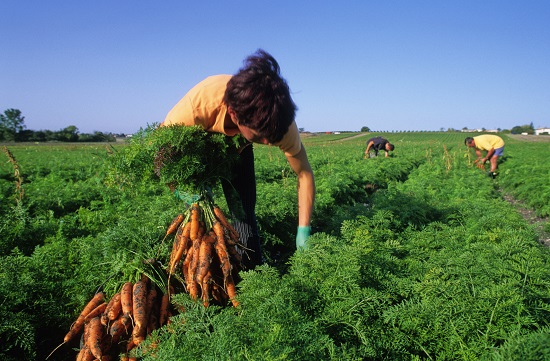An official website of the United States government
 United States Department of Labor
United States Department of Labor
| March 2015
There are hundreds of careers in our economy and multiple ways to group them. Organizing career information makes it more accessible to counselors, program planners, and others exploring jobs and occupations.
The Occupational Outlook Handbook (OOH) and other career resources from the Bureau of Labor Statistics (BLS) group jobs by occupation using the Standard Occupational Classification (SOC) system. Another way to sort jobs is with Career Clusters and pathways, a framework used by many schools and state agencies. Both methods of organizing career information are helpful for understanding the world of work, especially when they are used together.
This article helps to link BLS SOC-based career information with Career Clusters and pathways. The first section highlights OOH occupational profiles for each of the 16 Career Clusters and shows BLS data on wages, projected job openings, and more for selected occupations. The second section summarizes why both the SOC system and the Career Clusters framework are valuable and how BLS occupational information relates to clusters and pathways. The final section provides sources for learning more.
The National Association of State Directors of Career Technical Education Consortium, which oversees the Career Clusters framework, divides careers into 16 clusters. These clusters are further divided into pathways, which show more specific career areas with similar knowledge and skill requirements. The 16 Career Clusters are as follows:
• Agriculture, food, and natural resources
• Architecture and construction
• Arts, audio/video technology, and communications
• Business management and administration
• Education and training
• Finance
• Government and public administration
• Health science
• Hospitality and tourism
• Human services
• Information technology
• Law, public safety, corrections, and security
• Manufacturing
• Marketing
• Science, technology, engineering, and mathematics
• Transportation, distribution, and logistics
Each cluster description in the following sections includes links to the OOH profiles that most closely relate to the cluster. Each description also gives a snapshot of other BLS career information—including employment and wage data, education and training assignments, and projected job openings—to show how BLS material supplements Career Clusters and pathways.
Employment and wages. Employment and wage data are for May 2013 and exclude self-employed workers. The data for wages are presented as the median wage, meaning that half of workers in an occupation earned more than that amount, and half earned less. The median annual wage for all wage and salary workers was $35,080.
Education and training. Designations for each cluster discussion indicate what form of education and training BLS has determined is typically needed to enter an occupation.
Projected job openings. For each cluster, charts 1 through 16 show the occupations that BLS projects to have the most job openings between 2012 and 2022. Job openings come from the need to replace workers in an occupation and from newly created jobs.
According to BLS, about half of all job openings between 2012 and 2022 are projected to be in occupations assigned to four clusters: hospitality and tourism, business management and administration, marketing, and health science. (See table 1.)
| Career Clusters | Projected 2012–22 | |
|---|---|---|
| Job openings(1) | New jobs (2) |
|
|
Hospitality and tourism |
7,575,300 | 1,740,200 |
|
Business management and administration |
7,210,400 | 1,819,700 |
|
Marketing |
6,068,100 | 1,331,400 |
|
Health science |
5,575,300 | 3,079,800 |
|
Architecture and construction |
3,678,800 | 1,799,800 |
|
Transportation, distribution, and logistics |
3,672,700 | 993,700 |
|
Education and training |
3,311,400 | 1,163,300 |
|
Manufacturing |
3,077,100 | 360,000 |
|
Human services |
2,906,600 | 1,458,200 |
|
Finance |
2,054,900 | 567,400 |
|
Law, public safety, corrections, and security |
1,679,100 | 448,400 |
|
Information technology |
1,231,800 | 647,100 |
|
Agriculture, food, and natural resources |
813,600 | -81,200 |
|
Science, technology, engineering, and mathematics |
710,900 | 157,300 |
|
Arts, audio/video technology, and communications |
670,400 | 71,600 |
|
Government and public administration |
321,500 | 70,800 |
|
Sources: National Association of State Directors of Career Technical Education Consortium (Career Clusters); Bureau of Labor Statistics, Employment Projections program (data). |
||
|
Footnotes: |
||
Many of the job openings over the 2012–22 decade are projected to come from the need to replace workers who leave the occupation. However, for the occupations assigned to the health science, human services, and information technology clusters, BLS expects more job openings to come from newly created jobs.
Careers in the agriculture, food, and natural resources cluster involve working with plants, animals, and the environment. Nearly all of the farming, fishing, and forestry occupations and many of the life, physical, and social science occupations in the OOH are assigned to this cluster.

BLS counted about 1.4 million jobs in the SOC occupations that are assigned to the agriculture, food, and natural resources cluster. Median annual wages for these occupations ranged from $18,710 for crop, nursery, and greenhouse farmworkers and laborers to $116,840 for natural science managers.
Many of the occupations in this cluster typically require a high school diploma or equivalent, although specific designations range from less than a high school diploma and short-term on-the-job training for nonfarm animal caretakers to a doctoral or professional degree for animal scientists.
BLS projects the largest number of job openings in the agriculture, food, and natural resources cluster to be in occupations assigned to the plant systems pathway. The occupation expected to have the most job openings in the cluster is crop, nursery, and greenhouse farmworkers and laborers. (See chart 1.)

Careers in the architecture and construction cluster involve designing and building homes, roads, and other structures. Nearly all of the construction and extraction occupations and many of the architecture and engineering occupations in the OOH are assigned to this cluster.
BLS counted about 7.8 million jobs in the SOC occupations that are assigned to the architecture and construction cluster. Median annual wages for these occupations ranged from $23,940 for landscaping and groundskeeping workers to $84,410 for construction managers.
More than half of the occupations in this cluster typically require a high school diploma or equivalent. However, specific designations range from less than a high school diploma and short-term on-the-job training for carpet installers to a bachelor’s degree and an internship for occupations such as architects.
BLS projects most job openings in the architecture and construction cluster to be in occupations assigned to the construction pathway. The occupation expected to have the largest number of job openings in the cluster is construction laborers. (See chart 2.)
Careers in this cluster often involve creative tasks, such as performing or writing. Most of the arts and design, entertainment and sports, and media and communication occupations in the OOH are assigned to this cluster.
There were about 1.8 million jobs in the SOC occupations that are assigned to the arts, audio/video technology, and communications cluster, according to BLS. Median annual wages for these occupations ranged from $24,220 for floral designers to $83,000 for art directors.
Many occupations in this cluster typically require a bachelor’s degree, although specific designations vary. For example, public address system announcers typically need a high school diploma or equivalent and short-term on-the-job training, and art directors typically need a bachelor’s degree and 5 or more years of experience in a related occupation.
BLS projects most job openings in the arts, audio/video technology, and communications cluster to be in occupations assigned to the visual arts pathway, which includes graphic designers. This occupation is projected to have the most job openings in the cluster. (See chart 3.)
Careers in this cluster involve planning, oversight, and organizational tasks needed to run a business. Many of the business and financial, management, and office and administrative support occupations in the OOH are assigned to this cluster.

In the SOC occupations that are assigned to the business management and administration cluster, BLS counted about 23.3 million jobs—the most of all the clusters. Median annual wages for these occupations ranged from $22,480 for stock clerks and order fillers to $171,610 for chief executives.
More than half of these occupations typically require a high school diploma or equivalent, but specific designations range from less than a high school diploma and short-term on-the-job training for stock clerks and order fillers to a bachelor’s degree and 5 or more years of work experience in a related occupation for those such as computer and information systems managers.
BLS projects most job openings in the business management and administration cluster to be in occupations assigned to the administrative support pathway—including customer service representatives, the occupation expected to have the largest number of job openings in the cluster. (See chart 4.)
Careers in the education and training cluster involve teaching and other tasks associated with schools, libraries, and museums. All of the education, training, and library occupations in the OOH are assigned to this cluster.
BLS counted about 8.7 million jobs in the SOC occupations that are assigned to the education and training cluster. Median annual wages for these occupations ranged from $24,000 for teacher assistants to $105,080 for postsecondary law teachers.
Nearly all of the occupations in this cluster typically require a bachelor’s or higher degree for entry, and many teachers also must complete an internship. However, specific designations range from a high school diploma or equivalent for self-enrichment education teachers to a doctoral or professional degree and less than 5 years of work experience in a related occupation for postsecondary health specialties teachers.
BLS projects most job openings in the education and training cluster to be in occupations assigned to the teaching/training pathway. The occupation expected to have the largest number of job openings in the cluster is elementary school teachers. (See chart 5.)

Careers in the finance cluster involve managing and working with money. A number of the business and financial and office and administrative support occupations in the OOH are assigned to this cluster.
BLS counted about 5.3 million jobs in the SOC occupations that are assigned to the finance cluster. Median annual wages for these occupations ranged from $25,390 for tellers to $112,700 for financial managers.
Many of the occupations in this cluster typically require a bachelor’s degree for entry, although specific designations range from a high school diploma or equivalent and short-term on-the-job training for occupations such as loan interviewers and clerks to a bachelor’s degree and 5 or more years of work experience in a related occupation for financial managers.
BLS projects occupations in the banking services pathway to have the most job openings in the cluster. But the occupation expected to have the largest number of job openings is in the accounting pathway: accountants and auditors. (See chart 6.)
Careers in the government and public administration cluster involve making laws, ensuring safety, and providing other public services. All of the military careers in the OOH are assigned to this cluster. However, BLS does not collect employment and wage data, designate education and training, or make projections for military specific occupations. Therefore, the information that follows excludes these occupations.
BLS counted about 1 million jobs in the nonmilitary SOC occupations that are assigned to the government and public administration cluster. Median annual wages for these occupations ranged from $20,620 for legislators to $76,890 for financial examiners.
Many of the occupations in this cluster typically require a bachelor’s degree for entry, but specific designations range from a high school diploma or equivalent and short-term on-the-job training for transportation security screeners to a master’s degree for urban and regional planners.
BLS projects most job openings in this cluster to be in occupations assigned to the governance pathway. The occupation projected to have the largest number of job openings in the cluster is compliance officers. (See chart 7.)
Careers in the health sciences cluster involve helping people and animals with the medical care they need to get or stay healthy. Nearly all of the healthcare occupations in the OOH are assigned to this cluster.

BLS counted about 12.2 million jobs in the SOC occupations that are assigned to the health sciences cluster. Median annual wages for these occupations ranged from $21,020 for home health aides to more than $187,200 (the highest median annual wage published by BLS) for occupations such as surgeons.
Occupations in the health sciences cluster typically require many different levels of education and training, with specific designations ranging from less than a high school diploma and short-term on-the-job training for home health aides to a doctoral or professional degree and an internship or residency for occupations such as pediatricians.
BLS projects most of the job openings in occupations assigned to the health sciences cluster to be in the therapeutic services pathway. The occupation projected to have many more job openings than any other in the cluster is registered nurses. (See chart 8.)
Careers in this cluster involve providing people with food, lodging, and related services. All of the food preparation and serving occupations and a number of the personal care and service occupations in the OOH are assigned to this cluster.
BLS counted about 17 million jobs in the SOC occupations that are assigned to the hospitality and tourism cluster, making this cluster one of the largest in terms of jobs. Median annual wages for these occupations ranged from $18,330 for combined food preparation and serving workers to $66,200 for gaming managers.
Nearly all of the occupations in this cluster typically require a high school diploma or less education, although specific designations vary and include, for example, a bachelor’s degree for recreation workers.
BLS projects most of the job openings in occupations assigned to the hospitality and tourism cluster to be in the restaurants and food/beverage systems pathway. Of those occupations, the one expected to have the largest number of job openings is combined food preparation and serving workers. (See chart 9.)

Careers in the human services cluster involve helping people with a variety of needs, such as counseling and fitness training. Nearly all of the community and social service occupations and many of the personal care and service occupations in the OOH are assigned to this cluster.
BLS counted about 5 million jobs in the SOC occupations that are assigned to the human services cluster. Median annual wages for these occupations varied. For example, the median annual wage for shampooers was $18,510, and the wage for industrial-organizational psychologists was $80,330.
Occupations in the human services cluster typically require many different levels of education and training, with specific designations ranging from less than a high school diploma and short-term on-the-job training for occupations such as laundry and dry-cleaning workers to a doctoral or professional degree and an internship or residency for clinical, counseling, and school psychologists.
BLS projects occupations assigned to the personal care services pathway to make up nearly half of the projected job openings in the human services cluster. The occupation projected to have the most job openings in the cluster is personal care aides. (See chart 10.)
Careers in the information technology cluster involve working with computer hardware, software, or network systems. Nearly all of the computer and information technology occupations in the OOH are assigned to this cluster.
BLS counted about 3.5 million jobs in the SOC occupations that are assigned to the information technology cluster. Median annual wages for these occupations ranged from $46,620 for computer user support specialists to $101,410 for systems software developers.
Most occupations in this cluster typically require a bachelor’s degree for entry. However, specific designations range from some college but no degree and moderate-term on-the-job training for computer user support specialists to a bachelor’s degree and 5 or more years of work experience in a related occupation for computer network architects.
BLS projects more than half of all job openings in occupations assigned to the information technology cluster to be in the programming and software development pathway. The occupation projected to have the most job openings in the cluster is applications software developers. (See chart 11.)
Careers in this cluster involve protecting people and enforcing rules. All of the legal occupations and nearly all of the protective service occupations in the OOH are assigned to this cluster.

BLS counted about 4.9 million jobs in the SOC occupations that are assigned to the law, public safety, corrections, and security cluster. Median annual wages for these occupations ranged from $19,040 for lifeguards, ski patrol, and other recreational protective service workers to $118,150 for judges, magistrate judges, and magistrates.
Many occupations in this cluster typically require a high school diploma or equivalent. However, specific designations range from less than a high school diploma and short-term on-the-job training for occupations such as security guards to a doctoral or professional degree, 5 or more years of work experience in a related occupation, and short-term on-the-job training for judges, magistrate judges, and magistrates.
BLS projects occupations assigned to the security and protective services pathway to have the most job openings in the law, public safety, corrections, and security cluster. Among the occupations in this pathway is security guards, which is projected to have the most job openings in the cluster. (See chart 12.)
Careers in the manufacturing cluster involve making products, such as food, cars, and household goods. Nearly all of the production occupations, many of the installation, maintenance, and repair occupations, and some of the architecture and engineering occupations in the OOH are assigned to this cluster.
BLS counted about 11.8 million jobs in the SOC occupations that are assigned to the manufacturing cluster. Median annual wages for these occupations ranged from $21,490 for sewing machine operators to $78,350 for nuclear power reactor operators.
Most occupations in this cluster typically require a high school diploma or equivalent, although specific designations range from less than a high school diploma and short-term on-the-job training for occupations such as production worker helpers to an associate’s degree and long-term on-the-job training for camera and photographic equipment repairers.
BLS projects more than half of job openings in the manufacturing cluster to be in occupations assigned to the production pathway. However, the occupation expected to have the largest number of job openings is in the maintenance, installation, and repair pathway: general maintenance and repair workers. (See chart 13.)
Careers in the marketing cluster involve promoting and selling products and services. Most of the sales occupations and some of the management occupations in the OOH are assigned to this cluster.
BLS counted about 15.3 million jobs in the SOC occupations that are assigned to the marketing cluster, one of the largest in terms of jobs. Median annual wages for these occupations ranged from $18,960 for cashiers to $123,220 for marketing managers.
Many of the occupations in this cluster typically require a high school diploma or equivalent; however, specific designations range from less than a high school diploma for models to a bachelor’s degree and 5 or more years of work experience in a related occupation for occupations such as public relations and fundraising managers.
BLS projects most job openings in the marketing cluster to be in occupations assigned to the professional sales pathway. The occupation projected to have the largest number of job openings in the cluster is retail salespersons. (See chart 14.)

Careers in the STEM cluster involve solving problems through research and design. Many of the life, physical, and social science; architecture and engineering; and math occupations in the OOH are assigned to this cluster.
BLS counted about 2 million jobs in the SOC occupations that are assigned to the science, technology, engineering, and mathematics cluster. Median annual wages for these occupations ranged from $38,310 for social science research assistants to $132,320 for petroleum engineers.
Nearly all of the occupations in this cluster typically require a bachelor’s or higher degree for entry. But specific designations also include, for example, an associate’s degree for occupations such as social science research assistants.
More than half of the projected job openings in occupations assigned to the science, technology, engineering, and mathematics cluster are in the engineering and technology pathway. The occupation expected to have the most job openings in the cluster is mechanical engineers. (See chart 15.)
Careers in this cluster involve moving people and products from one place to another. Most of the transportation and material moving occupations and some of the installation, maintenance, and repair occupations in the OOH are assigned to this cluster.
BLS counted about 10.7 million jobs in the SOC occupations that are assigned to the transportation, distribution, and logistics cluster. Median annual wages for these occupations ranged from $19,500 for parking lot attendants to $121,280 for air traffic controllers.
Most of the occupations in this cluster typically require a high school diploma or equivalent for entry. However, specific designations range from less than a high school diploma and short-term on-the-job training for occupations such as taxi drivers and chauffeurs to a bachelor’s degree, less than 5 years of work experience in a related occupation, and moderate-term on-the-job training for airline pilots, copilots, and flight engineers.
BLS projects most job openings in the transportation, distribution, and logistics cluster to be in occupations assigned to the transportation operations pathway. The occupation projected to have the largest number of job openings is hand laborers and freight, stock, and material movers. (See chart 16.)
Although the SOC system and Career Clusters framework group jobs differently, both methods are designed to cover all types of work in our economy. Career planners may be familiar with one or both methods, but they may not realize that connecting these two systems broadens the scope of coverage. Linking a cluster or pathway to SOC occupations yields access to BLS data and information on employment, wages, projections, and more.
Several crosswalks, which provide a way to match one classification scheme to another, link the SOC occupations that BLS uses with Career Clusters and pathways. To help with career-search options, some crosswalks list the same occupation in more than one place. That way, someone who might be interested in an occupation would find it more easily.
This article, however, uses a crosswalk that assigns each occupation to just one cluster and pathway, which prevents an occupation from being counted more than once. (See table 5 of the Perkins IV crosswalk.) Using this crosswalk ensures a more accurate count of jobs.
Continue exploring BLS career information with the Occupational Outlook Handbook, which provides job descriptions, education and training requirements, data on employment and wages, and more for hundreds of occupations.
The full 2010 SOC system structure, including all 840 detailed occupations, their definitions, and illustrative examples, is presented on the SOC page on the BLS website.
The National Association of State Directors of Career Technical Education Consortium has more detail about the Career Clusters framework.
Check with your state’s Department of Education or your state’s labor market information office to learn about how Career Clusters and pathways are used in schools and workforce agencies near you.
For a complete list of the SOC occupations assigned to each of the Career Clusters and pathways, refer to the Perkins IV crosswalks created by the U.S. Department of Education.
The U.S. Department of Labor’s Occupational Information Network has a tool that lets you search for occupations by Career Cluster.
Elka Torpey, "Clusters, pathways, and BLS: Connecting career information," Career Outlook, U.S. Bureau of Labor Statistics, March 2015.